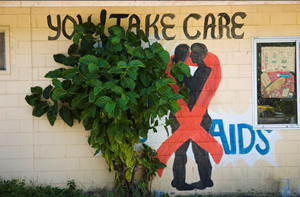It is almost exactly 30 years since Australia's first case of AIDS was confirmed. What followed was a disease prevention and public health education program that has long since been recognised around the world as one of the most successful HIV prevention campaigns.
That effort halted the spread of the disease in Australia and saved many lives. With access to good health care and antiretroviral drugs, people living with HIV in Australia can now lead a healthy life.
The same cannot be said for world's poorest and most vulnerable people, including in the Asia-Pacific region, where today an estimated 4.9 million people, including children, are living with HIV and AIDS.
The good news is that the rate of HIV infection in most countries across the region appears to have stabilised. In South and South-East Asia, the estimated 270,000 new HIV infections in 2010 were 40 per cent less than at the epidemic's peak in 1996.
Prevalence still remains highest among people who inject drugs, men who have sex with men, and sex workers and their clients. There are people still not able to access life-saving drugs. The fight is not yet over.
Australia's efforts to help control the spread of HIV in Asia and the Pacific
Australia's aid program has supported the global effort to achieve Millennium Development Goal 6 to halt and reverse the spread of HIV by 2015–particularly in our region.
Indonesia
In Indonesia, an estimated 310,000 people were living with HIV in 2009–almost the entire population of Canberra. Since 2008, Australia has been implementing the $100million, eight-year Australia Indonesia Partnership for HIV, which is focussing on preventing and limiting the spread of HIV, improving the quality of life of people living with HIV, and alleviating the socio-economic impacts of the epidemic.
This partnership is building on more than 16 years of Australian assistance on HIV in Indonesia and focusses on groups most at-risk, such as men who have sex with men and people who inject drugs. In 2011, more than 650,000 needles were distributed, and more people at risk gained access to a broad range of HIV services. For example, by 2012, the program had supported HIV programs in 92 correctional facilities in 11 provinces and by July 2011, more than 13 million male condoms and nearly 550 thousand female condoms were distributed through 4,066 condom outlets.
Papua New Guinea
In Papua New Guinea, in 2011, Australia's support for HIV programs helped more than 132,000 people find out their HIV status. This included more than 49,000 pregnant women (23 per cent of all pregnant women) through our direct support for 113 of PNG's 315 testing sites. Seventy-four per cent of Port Moresby's sex workers were provided with condoms in 2011, and more than 25 million condoms were distributed nation-wide.
The proportion of men, women and children receiving life-saving antiretroviral therapy increased from around 8,500 to more than 10,500 in 2011–84 per cent of PNG's HIV-positive population. In 2003, that number was zero. Australia supported more HIV treatment sites in 2011–helping to increase the national total from 61 in 2010 to 87 in 2011. HIV treatments are now available in every province of Papua New Guinea.
Supporting our major partners to make an impact
Last year, Australia supported UNAIDS by providing $9 million to help with the implementation of their work plan and the Regional Support Team for the Asia Pacific Region.
Since 2004, Australia has provided $250 million to the Global Fund to Fight AIDS, Tuberculosis and Malaria, with a further $170 million committed by July 2013. The Global Fund has supported HIV programs in 147 countries and is providing treatment for 4.2 million people living with HIV. Globally, 1.7million pregnant women are now receiving anti-retroviral treatment, which is helping to reduce the transmission of HIV to unborn children. More than 250 million people are receiving HIV counselling and testing sessions, and the number of condoms distributed grew from 3.5 billion to 4.2 billion between the end of 2011 and 2012.
The Global Fund also works hard to increase people's understanding of the impact of HIV/AIDS on the lives of people in developing countries. Just this week, with the support of AusAID and the Oil Search Health Foundation, The Global Fund and the Governor-General, Quentin Bryce, launched the Access to Life exhibition in Sydney to mark World AIDS Day 2012. The exhibition features more than 250 photographs capturing the human face of HIV and AIDS in 10 developing countries, including Papua New Guinea and Vietnam. It tells the poignant stories of people living with HIV and how their lives have changed after receiving life-saving antiretroviral treatment through the Global Fund.

